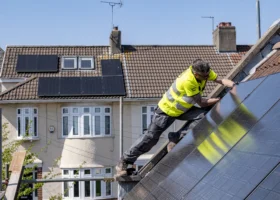
Treat yourself to our best ever subscription offer!
Just £12 for 12 issues
Treat yourself to our best ever subscription offer!
Just £12 for 12 issuesBattery storage has become increasingly popular over the past few years, with 2020 marking the start of a surge in uptake in homeowners installing battery storage systems. Traditionally, it was only considered when self builders and homeowners were installing solar electric (PV) panels or some other form of site-generated renewable power.
Now, however, we’re beginning to see battery storage systems being specified independently of renewables, driven by the desire to take advantage of cheap overnight electricity available under time-of-use energy tariffs. This could be a game changer in terms of the economics of battery storage.
In this article, I’m exploring the pros, cons, costs, carbon emission implications and potential savings on energy bills of installing battery storage – both with and without microgeneration. I’ll also look at the potential for interfacing with heat pumps, as well as the key factors that can affect the battery system’s performance, such as patterns of use.
Before we get too deeply into this, let’s make sure that we understand the basics of home batteries. Battery storage systems are designed to collect electrical power and store it for later use. The power input might come from a renewable source such as solar PV, or from the grid.
Domestic batteries are low voltage, so they always come with an inverter to transform the current to and from the higher 230V that’s required for domestic use. Installers should be members of the Renewable Energy Consumers Code (RECC), or similar, and certified under the Microgeneration Certification Scheme (MCS).
Domestic battery systems range in capacity from 2kWh to 20kWh. For reference, a 1kW heater operating for one hour would use 1kWh of electricity. The law of diminishing returns applies to batteries. The larger the battery system, the more self-generated and/or nighttime power you will be able to store – but there comes a point where the savings are outweighed by the costs of adding more capacity.

ISTOCK.COM/VECTORMINE
The average house using around 8kWh of electricity per day, and most domestic battery systems are currently within the 5kWh to 10kWh range. For context, an electric car battery will be more like 30kWh to 100kWh.
The cost of domestic battery systems of course varies according to size and supplier. Including installation, you might expect to pay around £6,000 for a small system (3kWh to 5kWh), and more like £10,000 for larger models, such as Tesla’s 13.5kWh Powerwall 3. Note that some battery systems are modular, which means more storage can be added at a reasonable cost.
How much you’ll save on bills depends on how you generate and use the energy, and the price of electricity (not just today, but across the useful life of the battery). While capital costs remain at the £6,000-£10,000 level, a battery storage system is currently unlikely to pay for itself during the installation’s lifetime. Battery lifespan is not yet clearly known, but 15 years is commonly quoted, and new systems often have a guarantee of 10 years.
The average gas-heated house spends £800 per year on electricity. If a battery system lasted 15 years and cost £6,000 to install, you would need to achieve electricity savings of at least £400 per year to make the financials stack up. A relatively small battery storage system is very unlikely to save as much energy as this.
Solar PV panels only produce electricity during the daytime, which means many households generate an excess that they can’t use on site. Rather than exporting this extra energy to the grid, battery storage enables you to make use of your own electricity at night.
How much this saves you depends on your energy usage profile. If there is plenty of daytime demand then you may use most of your PV-generated energy and have little to gain from adding a storage system. If the house is unoccupied during the daytime, then you will have more to gain from a storage system.
Savings also depend on whether you get a reasonable price for any electricity exports – if the rate is good, then it reduces the financial attraction of battery storage. The Smart Export Guarantee means that all energy suppliers of a certain size must offer to buy excess electricity. Some of the rates offered are very low, so check carefully if you expect to be selling power to the grid.

This Build It Award-winning SIPs self build by SIPS@Clays features a range of renewable systems to achieve net zero carbon, including a 6.4kW solar PV array, 3kW wind turbine and an MVHR system
Distributed energy and resilience are often mentioned as reasons to invest in battery storage systems. If the supply goes down then you have something to keep you going. Admittedly it doesn’t happen that often, but it could be a reason to consider PV and battery storage.
If you’re investing in a home battery as part of a new microgeneration system (alongside PV, for instance, or a wind turbine) then you won’t have to pay VAT. For those who already have solar PV and are thinking of investing in battery storage, a rule change in early 2024 means you no longer have to pay VAT to add it. However, a standalone battery without microgeneration will still be liable for VAT.
It’s a common myth that you can use a solar PV system to run a heat pump. PV output peaks in summer and space heating demand peaks in winter – so you have a complete mismatch here. Unfortunately, domestic battery systems won’t help with this inter-seasonal issue, as at best they can store energy for a single night in spring or autumn after a sunny day. What’s more, a battery’s maximum capacity is similar to daily demand from a heat pump, and your PV won’t be producing much energy in winter.
Are battery storage systems bad for the environment?Battery storage might save money and help to reduce the carbon intensity of the electricity supply overall, but it’s important to note batteries do have significant environmental impact. The main culprit here comes from the extraction of lithium used in most modern battery systems. Depending on system setup, it generally takes a few years for the embodied CO2 in domestic battery storage systems to be repaid. Bearing in mind the batteries are not expected to last more than 15 years on average, this becomes significant. There are other important environmental impacts of lithium-ion batteries:
The fact much of this pollution takes place far from the UK does not mean the impact is any less. There is a danger that, in trying to achieve zero carbon, we export a different kind of issue elsewhere. But positive initiatives are being adopted in the UK. Some companies use sustainable sourcing policies, such as repurposing used vehicle batteries and giving them a second life as home energy storage systems. |
If you’re on a time-of-use electricity tariff, it’s possible to take energy from the grid at night when it’s cheap, store it in batteries and then use it throughout the day, rather than buying in higher price electricity.
Under most Economy 7 tariffs, night-time electricity is less than half the cost of the daytime peak rates, so there’s potential for substantial savings. If you used no energy at all at night and had sufficient storage for everything you needed during peak times, you could cut your electricity bill by 50%. In reality, nobody’s usage is this regulated. Even if it were, it’s marginal as to whether a battery storage system could pay back within its expected lifespan. Plus, if you have a heat pump, you’re likely to have a high peak electricity demand. You’d need a very big battery storage system to serve in winter, pushing up the capital cost.
One question worth asking is whether the wide gap between peak and off-peak electricity prices will be maintained indefinitely. The answer is we simply don’t know. If lots of us switch to time-of-use tariffs and buy battery storage, the situation could quickly change. Perhaps we’ll see more dynamic pricing, where costs quickly respond to the needs of the grid.
Some suppliers’ time-of-use pricing encourages consumers to charge up their batteries at night and sell it back to the supplier at a higher rate during times of peak demand. You can actually make a profit this way, as some peak export rates are higher than import rates in the middle of the night. Effectively the energy company is employing pricing mechanisms to get consumers to use domestic battery systems as part of a smart grid, which may indicate the way of the future – a fully integrated, flexible electricity-based energy system.
Your complete guide to solar pv
CASE STUDY Coastal self build with battery storageA keen sailor, Adrian Evans lived in Brighton for many years, until an opportunity to create a new home from scratch just metres from the sea in Cornwall came along. Famous for surfing, messing about in boats and family holidays, this stretch of coast is a popular destination. “I’ve always wanted to self build and few plots in the country are this close to the beach,” says Adrian. “We just wanted to make the best of it.” And the result certainly does just that – a stunning four-bedroom contemporary eco home with a terrace and balcony that enjoys outstanding, uninterrupted views across a perfect sandy beach. Energy efficiency was important to Adrian, who prioritised a sustainable heating setup powered by renewables. This requires a suite of the latest technology. The property’s flat roof boasts 20kW of solar PV panels, facing east and west. These feed into a Tesla PowerWall battery and the two EV chargers. “We would love to have more battery storage,” says Adrian, as energy bills are still around £150 a month on average, dropping to £60 per month in the summer. Photos: Simon Burt |
Electric car owners already have a large battery storage system on or near their premises. Depending on the manufacturer, model and domestic charger installed, you may be able to use the batteries in reverse (bidirectionally).
So, as well as charging your car from the grid or from your PV array, the battery can also power your house. This is known as vehicle-to-home (V2H) or vehicle-to-grid (V2G).If your car is normally at home in the daytime, it may make sense to use it to supply electricity at peak times, only charging from the grid at times of lowest cost. Octopus Energy, for example, has already trialled this approach.
